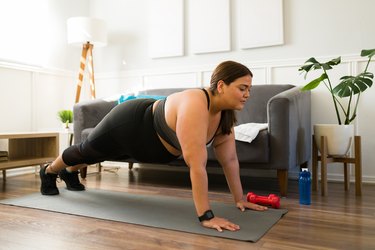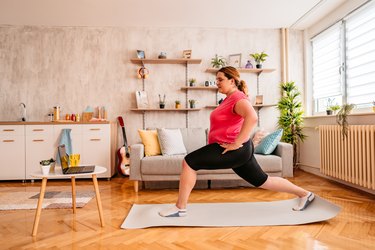

Core exercises are an important component of any well-rounded fitness routine. However, for people with larger bodies, core exercises can be intimidating or downright uncomfortable.
"Many of my clients are intimidated by core exercises because sometimes our bodies move a little differently," says Sarah Taylor, CPT, a plus-size personal trainer and virtual studio owner.
Video of the Day
For some plus-size exercisers, having a larger stomach or chest can make moves like sit-ups and crunches tricky, while others find it challenging to get on the floor.
"Exercises and specific movements aren't one-size-fits-all. There are reasons we lift with certain form for safety and efficiency, but again, everyone's body is different and so each movement we do should be done a little differently for each person," says Morit Summers, CPT, founder of Form Fitness Brooklyn.
Then, there's the confusing way many fitness pros talk about core exercises.
"The messaging in the fitness industry has been all about six-packs, and not about the actual core. So there's a lot of misinformation about what core exercises are actually training," Taylor says.
A "six-pack" simply refers to the superficial abdominal muscles — mainly, the rectus abdominis — that become visible when your body fat gets low enough. Meanwhile, your "core" encompasses a whole lot more: the "six-pack" muscles, along with deeper muscles, like your transverse abdominis and obliques, that support, twist, bend and lengthen your spine.
A strong core ranks higher than defined abs because it will help with carrying out daily activities in everyday life.
Here, Summers and Taylor share seven beginner core exercises for people with obesity or overweight, along with suggestions for modifying each.
Tip
If you're new to exercise, start with 3 sets of 8 reps per move. You can also incorporate these moves into your regular core workout. As you get stronger, you can gradually increase the reps and do 3 sets of 10 reps. Aim to do these exercises three times a week for the best results.
1. Bird Dog
"We walk through life with a cross-body pattern and having rotation in the hips. The bird dog helps to work on coordination and core stability," Summers says.
- Get on your hands and knees in a tabletop position with your shoulders over your wrists and your hips over your knees.
- Brace your core and lift your opposite arm and leg off the floor to create a straight line from your heel to your fingertips.
- Return your arm and leg back to the center. This is 1 rep. Extend your arm and leg back out. Think about lengthening instead of lifting your arm and leg high to prevent your lower back from overextending.
- Keep your neck neutral throughout the exercise.
Modification and Progression
Modification: If you have some trouble getting on the ground, perform this exercise from a standing position. Extend one arm in front of your body and the opposite leg behind, leaning your torso forward and keeping your hips squared.
Progression: If you’re ready to make the exercise more challenging, hold small weights in your hands or loop a resistance band around both thighs (just above the knees).
2. Pallof Press
The Pallof press is one of the best anti-rotation core exercises for building strength and stability, Summers says. You can use resistance bands or a cable machine.
- Loop a resistance band around an anchor.
- Stand with your right side facing the anchor, far away enough so that you’re pulling significantly on the band. Situate your feet shoulder-width apart and bend your knees slightly.
- Hold the band with both hands at your chest or abdomen (depending on the height of the band).
- Extend your arms out in front of you until your elbows are straight.
- Bring your hands and the band back into your chest or abdomen. This is 1 rep. Throughout the movement, use your core muscles to keep your torso from rotating.
- Complete all reps, and repeat with the other side facing the anchor.
Modification and Progression
Modification: If you're feeling some discomfort in your outside knee and are resisting rotation from your knee instead of your core, then you can try a half-kneeling or kneeling Pallof press.
Progression: If the resistance feels too easy, stand farther away from the anchor to increase the resistance.
3. Dead Bug
The dead bug may look like fairly simple move, but it requires strong core engagement. It targets your transverse abdominis as well as your erector spinae (deep back muscles), which support your lower back. Dead bugs also help improve coordination as you move opposite limbs.
- Lie on your back with your knees bent and your feet flat on the floor.
- Press your lower back into the ground and lift both knees until your shins are parallel to the floor.
- Extend your arms toward the ceiling.
- Brace your core and slowly lower one arm toward the floor alongside your ear while you straighten the opposite leg.
- Only lower your limbs as far as you can without letting your lower back arch.
- Return to the starting position. This is 1 rep. Repeat with the opposite arm and leg.
Modification and Progression
Modification: Lower only one limb (arm or leg) at a time until you’re able to move both.
Progression: Loop a resistance band around both feet, or hold small weights in your hands.
4. Glute Bridge
In addition to working your hips and hamstrings, glute bridges also activate your core. You need to brace your core to drive your hips off the ground and stabilize your body at the top of the movement.
- Lie on your back with your knees bent and your feet flat on the floor, hip-width apart. Let your arms rest on the floor alongside your torso.
- Brace your core and squeeze your glutes to start lifting your hips toward the ceiling.
- Raise your hips as high as possible without arching your back.
- Squeeze your glutes in the top position and hold this position briefly.
- Slowly lower your hips down to the floor. This is 1 rep. Repeat.
Modification and Progression
Modification: Place both feet flat against a wall instead of on the floor.
Progression: Taylor suggests squeezing a Pilates ball between your knees as you perform the movement. Another option is to loop a resistance band around both thighs (just above your knees).
5. Plank
Another great beginner core exercise for people with obesity, planks build core stability and overall body strength. When holding a plank, you're also contracting your glutes and quads to help lighten the load on your lower back, and working your shoulders and back to keep your body in a straight line.
- Get into a push-up position on the floor: arms straight, palms flat on the floor in line with your shoulders, legs extended behind you with your weight on your toes.
- Brace your core and squeeze your glutes and quads.
- Keep your body in a straight line from the top of your head to the tops of your heels; don’t let your hips drop toward the floor or push toward the ceiling.
- Aim to hold for 10 seconds, then drop to your knees and repeat. Over time, you can work your way to holding a plank for 15 to 30 seconds.
Modification and Progression
Modification: You can do a plank on an incline by placing your hands on a box, countertop or wall. Or you can do a forearm plank or come down to your knees. Just remember to keep your wrists (or elbows) under your shoulders and your core tight by keeping your pelvis tucked.
Progression: To make this move harder, tap your shoulder with your alternate hand. Or try elevating your feet on an aerobic step or exercise ball. You can also ask a friend to set a weight plate on your back.
6. Heel Tap
This exercise forces your core and back to stabilize as you tap your heel to the ground. Tacking this move onto your ab workouts is also a great way to engage your pelvic floor during exercise.
- Lie on your back with your knees bent and your feet flat on the floor.
- Press your lower back into the ground and lift both knees until your shins are almost parallel to the floor. Let your arms rest on the floor alongside your torso.
- Drop both heels toward the ground with control. Don’t let your lower back arch or your head come off the floor.
- Lightly tap the ground with your heels.
- Raise both knees to the starting position. This is 1 rep. Repeat.
Modification and Progression
Modification: Tap one heel at a time instead of both. Or, start with your feet on the ground and lift one leg, not both. You can also perform this exercise from a seated position if you have a hard time getting to the ground, Taylor says.
Progression: Loop a resistance band around both knees or hold a weight in front of your chest.
7. Standing Core March
Another great option for those who can't get down on the floor, this move gets your shoulder and core stabilizers working to help you balance and keep weight overhead as you move your legs.
Two main things you want to focus on are to push through the floor with the foot that stays connected to the ground and to stabilize your glutes so you're not tipping to one side, Summers says.
- Stand tall and hold a small dumbbell overhead so your palm faces in.
- Brace your core and lift the opposite knee toward the center of your body. Only lift your knee as high as you can without losing balance or dropping your chest.
- Return your foot to the floor with control. This is 1 rep. Repeat.
- Continue until you’ve completed all reps on one side, and then switch.
- Keep the weight pressed overhead throughout the movement; don’t let your elbow bend.
Modification and Progression
Modification: Drop the weight and perform the move with your arms to make it easier.
Progression: Increase the weight or place a resistance band around your feet to make it harder.



